
Want to stay ahead in the gifting game? Understanding the latest gift industry statistics and trends is key.
But with so much information, it’s hard to know what’s important and what’s not.
That’s why I’ve researched for you. This article shares the most crucial gifting industry statistics, covering topics like regifting, sustainability, and consumer behavior.
Whether you’re a business owner, marketer, or just a curious gift-giver, this article will help you make informed decisions and stay on top of the latest gifting trends.
Key Gift Industry Statistics (Editor’s Pick)
- According to a report by Mordor Intelligence, the gifts retailing market is projected to grow from $14 billion in 2024 to $17.13 billion by 2029 at a compound annual growth rate (CAGR) of 4.12% over the five years.
- The global gift cards market hit $1.128 trillion in 2023 and is expected to surge at a 16.3% CAGR from 2024 to 2032, reaching $4.399 trillion by 2032.
- The global personalized gifts market is poised for rapid expansion. Its global value is set to surge from $28.19 billion in 2023 to $57.85 billion by 2031.
- Most manufacturers (73%) say companies prefer eco-friendly gift packaging because it cuts costs and benefits the environment.
- The global corporate gift market is expected to grow from $252.6 billion in 2023 to $365.8 billion by 2032 at a rate of 4.2% per year, driven by increased corporate events and celebrations.
- The US gift card market will grow by 7.2% annually, reaching $214.3 billion in 2024 and $267.3 billion by 2028, with a 5.7% CAGR from 2024-2028.
- 47% of US adults hold unused gift cards or vouchers worth $187 each, totaling $23 billion nationwide.
- As of 2023, the US has 54,863 gift shops and card stores, representing a slight decrease of 0.6% compared to the previous year (2022).
- Nearly half of Americans (43%) consider cash to be the most desirable Christmas gift, bringing them the greatest happiness.
- The global digital gift card market is projected to grow from $310.1 billion in 2022 to $1.2 trillion by 2032 at a CAGR of 12.5%.
- 30% of respondents said they’d be happiest receiving a gift card or voucher as a Christmas gift, making it the most popular choice.
- 60% of US consumers planned to buy gifts for their significant other and children, a slight increase from the previous year for both groups.
- 68% of employees prefer to select their own gifts rather than relying on their employer to choose one for them.
- 60% of customers prefer gift cards as rewards from brands or retailers rather than discounts, coupons, bonus dollars, or other offers.
- 61% of consumers overspend gift cards by an average of $31.75, exceeding the card’s value.
- South Africa’s gift card market is expected to grow from $1.2 billion in 2023 to $1.9 billion by 2028 at a CAGR of 10%, reaching $1.3 billion in 2024.
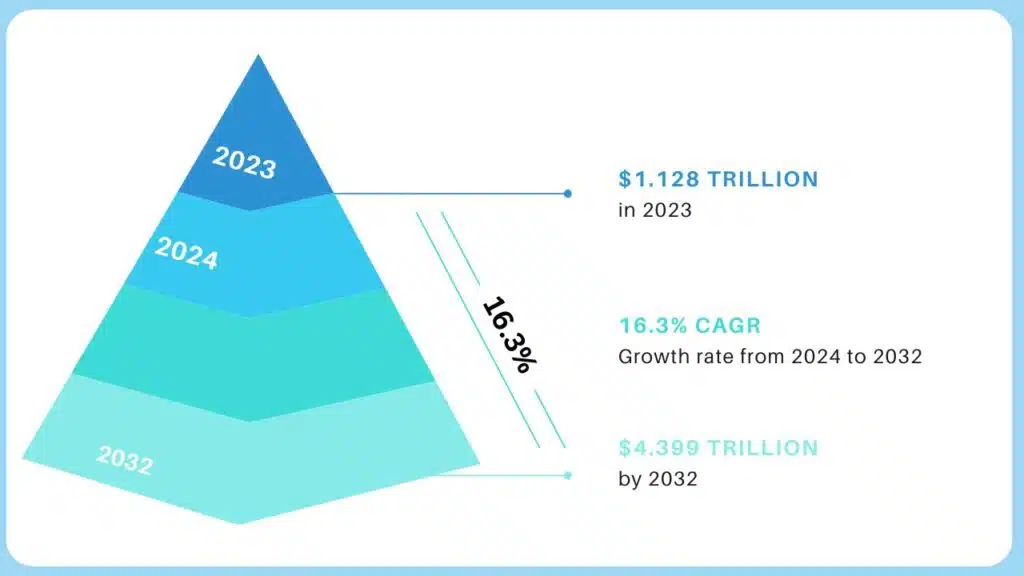
Gift Industry Statistics
1. According to a report by Mordor Intelligence, the gifts retailing market is projected to grow from $14 billion in 2024 to $17.13 billion by 2029 at a compound annual growth rate (CAGR) of 4.12% over the five years. (source)
2. The global personalized gifts market is expected to experience robust growth, with its value rising from $23.5 billion in 2019 to an estimated $34.3 billion by 2026, driven by increasing demand for unique and customized gifts. (source)
3. In the UK, online search trends as of January 2022 reveal significant shifts in gift-related queries. ‘Christening gifts’ saw a remarkable 639% surge, followed by a 123% increase for ‘Buy a gift.’ Meanwhile, ‘Secret Santa gifts’ experienced a 43% growth. In contrast, searches for ‘Personalized gifts’ declined by 36%. (source)
4. The global gifts retail market reached $65 billion in 2021 and is expected to grow to $94 billion by 2031, with a compound annual growth rate (CAGR) of 3.74% over the next decade. (source)
5. The global gift cards market reached a staggering value of $1.128 trillion in 2023 and is projected to experience rapid growth from 2024 to 2032, with a compound annual growth rate (CAGR) of 16.3%. By 2032, the market is expected to balloon to $4.399 trillion. (source)
6. The Japanese gifts market is projected to surpass 11 trillion yen in retail value by 2024, up from less than 10 trillion yen in 2015. This indicates a substantial expansion in the industry over the past decade. (source)
7. The global personalized gifts market is poised for rapid expansion. Its global value is set to surge from $28.19 billion in 2023 to $57.85 billion by 2031, representing a significant growth rate of 9.40% per annum over the eight-year forecast period. (source)
8. The global gift packaging market is projected to experience steady growth, increasing from a current value of $25.3 billion in 2023 to a forecasted $37.4 billion by 2033, representing a compound annual growth rate (CAGR) of 4.3% over the next decade. (source)
9. The global gift box market is expected to grow from $2.018 billion in 2023 to $3.753 billion by 2033, at a CAGR of 6.4%. This industry is characterized by a fragmented landscape, with key players primarily based in developed nations like the US, and is influenced by two dominant trends: franchising and retail expansion. (source)
10. The global gift paper market is expected to grow significantly from 2023 to 2033, increasing from $4.49 billion to $6.65 billion at a 4.0% annual growth rate. This industry accounts for 2-3% of the global paper market in 2023 and is projected to continue thriving over the next decade. (source)
11. Most manufacturers (73%) say companies prefer eco-friendly gift packaging because it cuts costs and benefits the environment. (source)
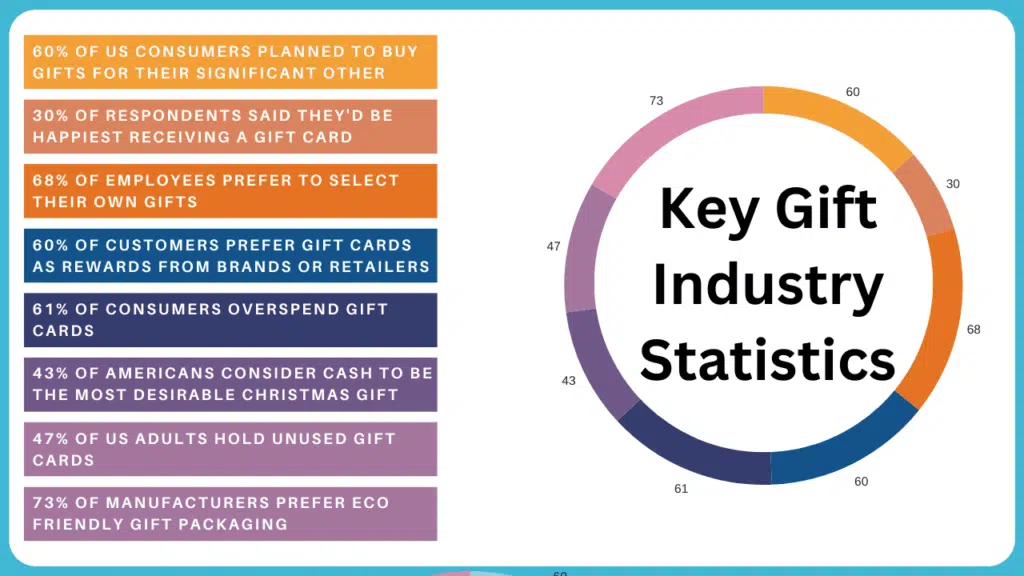
12. India’s gift paper market is expected to grow to $442.9 million by 2033, building on its 6.1% global market share in 2022. (source)
13. The US dominates the gift packaging market, accounting for 14.3% of global sales, followed by Canada with 1.5%. The US has the largest global market share, driving a significant portion of the industry’s revenue. (source)
14. The Paper and paperboard segments are expected to account for a major share of the global gift packaging market, making up 43% of the industry. (source)
15. The global corporate gift market is expected to grow from $252.6 billion in 2023 to $365.8 billion by 2032 at a rate of 4.2% per year, driven by increased corporate events and celebrations. (source)
16. Japan’s year-end gifts market was worth 858 billion yen in 2023 but is forecast to dip to 842 billion yen in 2024. (source)
17. The Asia Pacific region leads the global Floral Gifting market, boasting an impressive 22% market share and driving remarkable growth in the industry. (source)
18. The Asia Pacific floral gifting market reached $11.11 billion in sales revenue in 2023. (source)
19. UK online searches for ‘Buy a Gift’ soared by 123% in January 2022, followed by ‘Virgin Experience Days’ with an 83% increase, revealing a rising demand for experiential gifts. (source)
20. India’s gift card market is projected to surge from $11.88 billion in 2024 to $26.81 billion by 2029, with a remarkable 17.67% annual growth rate. (source)
21. Indian OTT platforms SonyLiv and Zee5 offer gift cards with discounts of up to 50% and 25%, respectively, to incentivize users. (source)
22. Australia’s gift card market is expected to grow over 8% annually during the forecast period. (source)
23. US gift, novelty, and souvenir stores generated $21.15 billion in sales in 2022, a small increase from the previous year. (source)
24. Additionally, US gift, novelty, and souvenir stores are expected to bring in around $16.6 billion in revenue by 2024. (source)
25. In 2018, the US market for plastic gift-wrapping products was worth $500 million. It’s expected to grow to $790 million by 2025. (source)
26. The global hotel gift card market earned $53.3 billion in 2022 and is expected to grow rapidly at a rate of 14.3% per year, reaching a massive $228.1 billion by 2033. (source)
27. Italy’s gift card market, including vouchers and coupons, is projected to be worth around $85 million by 2025. (source)
28. Italy’s gift card market is expected to grow by $3.17 billion between 2021 and 2026 at an annual rate of 8.61%. The growth is driven by the increasing popularity of gift-giving and the demand for seasonal decorations. However, the perception that gift cards are impersonal may limit the market’s growth. (source)
29. The Middle East gift card market earned $27 billion in 2023 and is expected to grow at a rate of 7% per year going forward. (source)
30. According to Mordor Intelligence, the first quarter of 2020 saw a massive 250% increase in e-gift card adoption compared to the same time in 2019. (source)
31. The gift-wrapping products market was worth $15.11 billion in 2018 and is expected to grow to $24.9 billion by 2025, representing a significant increase in global demand. (source)
32. According to Zion Market Research, the global gift box market was valued at $1.6 billion in 2022 and is projected to expand to $2.6 billion by 2030, growing at a steady rate of 6.5% per year from 2023 to 2030. (source)
The increase is driven by the growing trend of gift-giving and the rise of e-commerce. The market is segmented by material, with plastics expected to lead, and by application, with cosmetic and personal care products expected to dominate. Geographically, North America is anticipated to be the largest market for gift boxes during the forecast period.
33. A recent survey conducted in the United States in October 2023 reveals that over half of American consumers (51%) begin their Christmas gift shopping before December, indicating an early start to the holiday shopping season. (source)
34. The luxury gift boxes market is poised for significant growth, with a projected CAGR of 5.5% from 2022 to 2030. The cosmetics and fragrances sector leads the market, commanding over 30% of the revenue share, driven by the increasing demand for premium packaging in the beauty industry. (source)
35. Colombia’s gift card market achieved a value of $990.7 million in 2023 and is anticipated to expand significantly, reaching $3.007 billion by 2032. The market is expected to grow at a robust compound annual growth rate (CAGR) of 13% from 2024 to 2032. (source)
36. Singapore’s gift card market is expected to grow 11.7% to $1.183 billion in 2022 and reach $1.7 billion by 2026, with a CAGR of 9.5% from 2022 to 2026. (source)
37. In Spain, online marketplaces and pure players were the top gift shopping channels in 2021, used by 15% of respondents, followed by traditional online retailers (7%), brand websites (5%), and social media/other channels (2%). (source)
38. In the UK gift industry, notonthehighstreet.com led online visibility in January 2022 with a score of 83,188, followed closely by buyagift.co.uk with a score of 34,339, making them the top two online retail websites in the sector. (source)
39. France’s Gift Card market will surge from $35.8 billion in 2023 to $86.8 billion by 2032, growing at a 10.33% CAGR. This expected increase is due to the growing digitalization trend as more people favour digital gift cards over traditional paper gift cards. (source)
40. Spain’s e-commerce gift market revenue fluctuated significantly from Q1 2014 to Q4 2019, reaching its highest point in Q1 2018 with around €120 million in sales. (source)
41. The Canada gift card and incentive card market is projected to grow at a CAGR of greater than 8% from 2024 to 2029. (source)
42. The global floral gifting market reached $50.10 billion in 2021 and is expected to reach $76.22 billion by 2030, with a steady growth rate of 6.1% per annum from 2022 to 2030. (source)
43. The US gift card market will grow by 7.2% annually, reaching $214.3 billion in 2024 and $267.3 billion by 2028, with a 5.7% CAGR from 2024-2028. (source)
44. 47% of US adults hold unused gift cards or vouchers worth $187 each, totaling $23 billion nationwide. (source)
45. The US gift card market is experiencing consolidation, with major players acquiring smaller companies to strengthen their market position. Recent examples include Blackhawk Network’s acquisition of Tango Card in January 2024 and RDE’s purchase of CardCash.com in January 2024, expanding their presence in the industry. (source)
46. Payment companies are teaming up with gift card providers to capitalize on the increasing demand for digital payment tools. Recent partnerships include Affirm’s collaboration with Blackhawk Network in December 2023 and Venmo’s partnership with InComm in October 2023 to offer digital gift cards, further expanding the reach of gift card services. (source)
47. The Non-photo personalized gifts market is set to grow to $9.12 billion by 2027, at 8.87% CAGR from 2023. North America will account for 41% of global market growth during the forecast period. (source)
48. On average, American consumers spent around $920 on Christmas gifts in 2022, a modest decline from the previous year’s average expenditure. (source)
49. German consumers were expected to spend €44 on Christmas gifts at department stores in 2023. (source)
50. According to Technavio, the personalized gifts market is expected to grow to $14.98 billion by 2028, at 8.35% CAGR from 2023. (source)
51. UK consumers’ top Christmas gift choice is vouchers/gift cards, preferred by 39%. (source)
52. The UK market for personalized gifts is expected to grow to $1.13 billion by 2028, expanding at a compound annual growth rate (CAGR) of 10.87% from 2023 to 2028. (source)
53. The global gifts retailing market is expected to expand by $11.01 billion between 2023 and 2028, growing at a CAGR of 2.43%. Driving forces include increasing demand for seasonal decorations and a growing gifting culture. However, intense market competition poses a challenge due to pricing pressures. (source)
54. By 2028, Europe is forecasted to dominate the global gifts retailing market, accounting for 48% of the market share. (source)
55. India’s gifting market reached $72.56 billion in 2023 and is poised for strong growth, expanding at a CAGR of 3.35% from 2023 to 2028. (source)
56. As of 2023, the US has 54,863 gift shops and card stores, representing a slight decrease of 0.6% compared to the previous year (2022). (source)
57. The US Gift Shops & Card Stores industry is labor-intensive, with the highest costs being Wages (15.4%), Purchases (45.3%), and Rent & Utilities (5.2%) as a percentage of revenue. (source)
58. The US Gift Shops & Card Stores industry generated $24.5 billion in revenue in 2023, marking a 3.2% increase from the previous year and a 0.8% annual growth rate from 2018 to 2023. (source)
59. According to a 2023 survey, nearly half of Americans (43%) consider cash to be the most desirable Christmas gift, bringing them the greatest happiness. (source)
60. In 2024, you can give up to $18,000 to anyone without paying federal gift tax, an increase from $17,000 in 2023. This means individuals can give up to $18,000 tax-free to each recipient in 2024, and married couples can give up to $36,000. The combined exemption allows individuals to transfer up to $13.61 million tax-free during their lifetime or at death. (source)
61. Canada’s Gift Shops & Card Stores market has experienced steady growth, with revenue increasing by 1.2% annually over the past five years, reaching an estimated value of $3.5 billion in 2023. (source)
62. Canada’s Gift Shops and Card Stores industry is fragmented, with the top four players holding less than 40% of the market share. The industry’s concentration level is relatively low, averaging 29%. (source)
63. In the US, 50% of Gen Z and millennials are more likely to give personalized gifts in 2023, up from last year, while only 25% of baby boomers feel the same way. (source)
64. In the US, as of September 2023, 63% of shoppers prefer online-only retailers for holiday gifts, followed by mass merchants (53%), while only 25% opt for off-price stores, department stores, or warehouse clubs. (source)
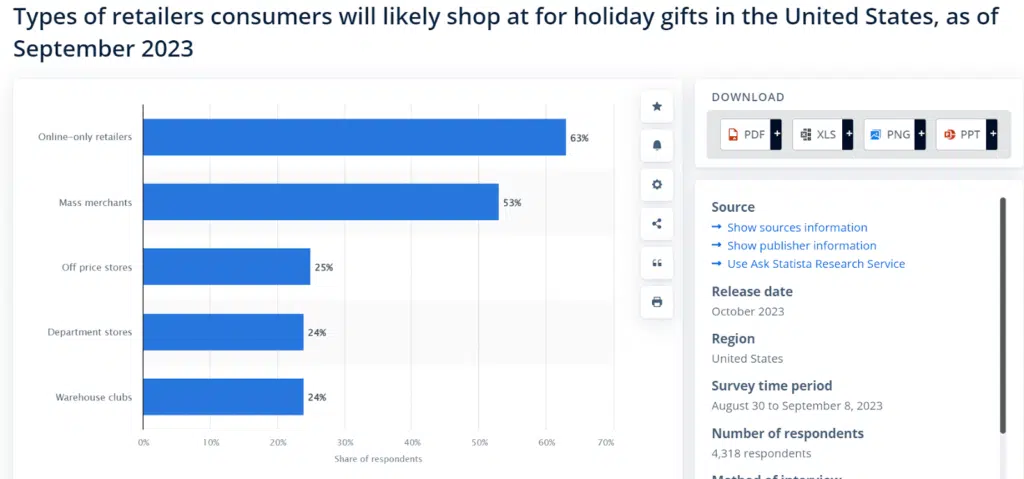
65. The global gifting market is valued at $475 billion, with India expected to reach $84 billion by 2024, making it a significant player in the industry. (source)
66. India’s Diwali gifting market is growing rapidly, increasing from ₹1.5 lakh crore (US$20 billion) in 2022 to over ₹2 lakh crore (US$27 billion) in 2023. (source)
67. Germany’s gift card market is expected to grow significantly, from $66.4 billion in 2023 to $171.9 billion by 2032, at an impressive 11.15% CAGR. (source)
68. The global digital gift card market is projected to grow from $310.1 billion in 2022 to $1.2 trillion by 2032 at a CAGR of 12.5%. (source)
69. In an October 2023 French survey, 30% of respondents said they’d be happiest receiving a gift card or voucher as a Christmas gift, making it the most popular choice. (source)
70. In an October 2023 Mexican survey, over 50% of respondents said they’d be happiest receiving clothes, textiles, or shoes as a Christmas gift, making it the clear top choice. (source)
71. In Brazil, tech gifts top Christmas wish lists, with 40% of survey respondents in October 2023 saying they’d love to receive a smartphone, tablet, or accessory. (source)
72. A September 2023 survey found that 60% of US consumers planned to buy gifts for their significant other and children, a slight increase from the previous year for both groups. (source)
73. US consumers planned to spend an average of $170 per person on gift cards and $120 per person on clothing during the 2023 holiday season. (source)
74. 68% of employees prefer to select their own gifts rather than relying on their employer to choose one for them. (source)
75. Australia’s online corporate and promotional gift market has experienced a 7.5% annual decline over the past five years, with revenues expected to drop to $188.6 million by 2024. (source)
76. Over 30% of Australians intend to boost their online gift-shopping habits. (source)
77. In the 2023 US holiday season, 65% of female consumers prioritized price when purchasing, with convenience and fast delivery also being key considerations. (source)
78. The Asia Pacific region accounts for 23% of the total revenue in the global gift retail market, equivalent to $4.4 billion. This segment is expected to expand at a CAGR of 5.6% from 2024 to 2031, driving the market’s growth. (source)
79. China’s gift industry boomed in 2023, reaching a staggering 1.3 trillion yuan, with projections to surpass 1.6 trillion yuan by 2027. Notably, curated gift sets and boxes featuring speciality foods, fashion accessories, and cultural creations are gaining immense popularity among Chinese consumers during the festive seasons. (source)
80. China’s gift industry experienced a 6% growth in 2023, reaching a new high, and is expected to maintain this momentum with a similar growth rate in 2024. (source)
81. China dominates the global gift and premium market, producing over 80% of its promotional products, cementing its position as the largest manufacturer of giveaway items worldwide. (source)
82. Most younger consumers (67% of millennials and 57% of Gen Z) have purchased a gift card in the past year, preferring physical or digital options. (source)
83. Digital gift card purchases tend to be more planned, with 28% bought over a week in advance, compared to 13% of physical gift cards. However, last-minute purchases are more common with physical gift cards, with 32% bought on the same day they’re given, versus 21% of digital gift cards. (source)
84. The global wedding gift list service market is projected to grow from $220.37 billion in 2023 to $505.57 billion by 2030 at a compound annual growth rate (CAGR) of 12.6% from 2024 to 2030. (source)
85. 64% of consumers prefer to buy gift cards from stores offering diverse cards from multiple retailers or brands. (source)
86. Consumers’ preferred channels for buying gift cards are:
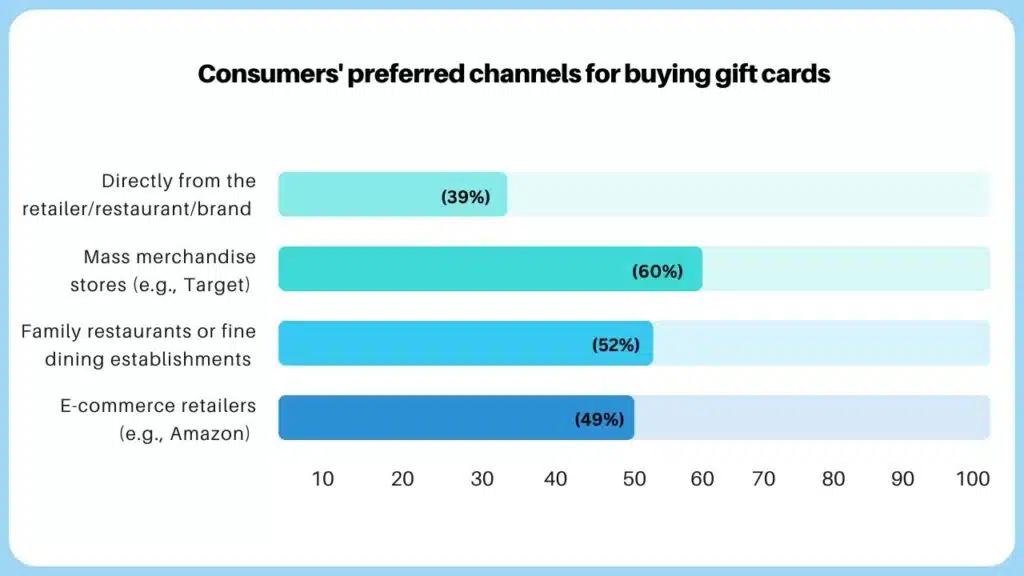
- Directly from the retailer/restaurant/brand (39%)
- Mass merchandise stores (e.g., Target) (60%)
- Family restaurants or fine dining establishments (52%)
- E-commerce retailers (e.g., Amazon) (49%) (source)
87. “On average, consumers purchased 6.4 physical gift cards in the past year, with 60% being for gifts and 40% for personal use. Additionally, 42% of consumers buy physical gift cards regularly, purchasing at least every three months. (source)
88. The use of physical gift cards increases with age, with the following percentages of each generation reporting having used a physical gift card:
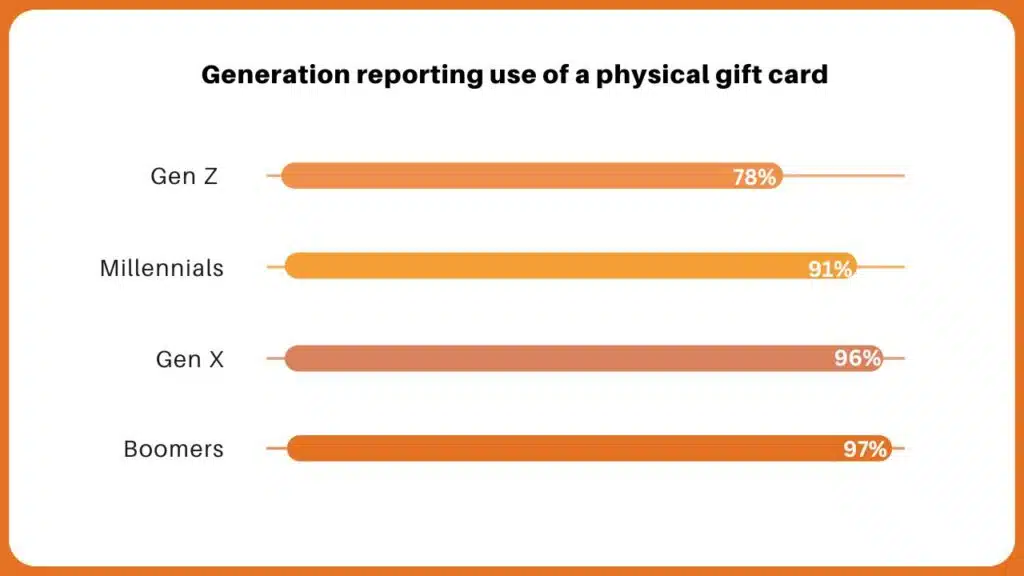
- Gen Z: 78%
- Millennials: 91%
- Gen X: 96%
- Boomers: 97%
Most (94%) of all consumers have used a physical gift card at some point. (source)
89. Millennials lead the way in using digital gift cards with a significant margin. The percentage of each generation that has used digital gift cards is:
- Millennials: 75%
- Gen X: 72%
- Gen Z: 65%
- Boomers: 61% (source)
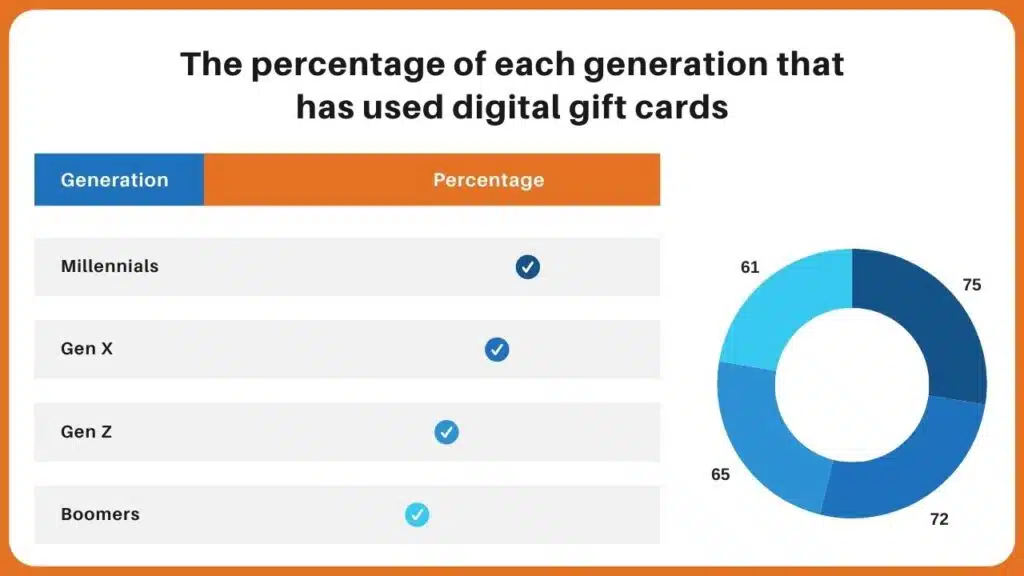
90. 86% of consumers use gift cards at familiar retailers, with 93% of Boomers doing so. (source)
91. 69% of employees view receiving a gift card from their employer as a financial reward or cash bonus, indicating a positive perception of gift cards as a form of recognition. (source)
92. 60% of customers prefer gift cards as rewards from brands or retailers rather than discounts, coupons, bonus dollars, or other offers. (source)
93. 61% of consumers overspend gift cards by an average of $31.75, exceeding the card’s value. (source)
94. South Africa’s gift card market is expected to grow from $1.2 billion in 2023 to $1.9 billion by 2028 at a CAGR of 10%, reaching $1.3 billion in 2024. (source)
95. 89% of respondents have received a present, with siblings and friends being the most common recipients (both at 39%). Partners and coworkers also receive regifted presents, at 38% and 34%, respectively. (source)
96. Drink products are the most frequently regifted items, with 39% of recipients having regifted alcohol, tea, or coffee sets. Beauty products like perfume and makeup come second (35%), closely followed by food (34%) and toiletries (27%) as popular regift choices. (source)
97. The primary motivations for regifting are convenience (38%) and environmental benefits (37%), followed by cost savings, with 30% of respondents opting for regifting as a cheaper alternative to buying new gifts. 72% of respondents plan to regift this year, with 53% more likely to do so due to the cost-of-living crisis. (source)
98. A US survey revealed that when it comes to gift-giving, 24% of households prioritize their children, allowing them to open their gifts first. Meanwhile, 20% of Americans don’t have a specific approach or tradition surrounding gift-giving. (source)
Conclusion
Now that you’ve got the latest gifting industry statistics at your fingertips, you’re ready to take your gifting game to the next level.
With these insights, you can create effective marketing strategies, make informed business decisions, and become a more thoughtful gift-giver.
Don’t let gifting trends pass you by – use these statistics to stay ahead of the curve and make a lasting impact. By applying what you’ve learned, you’ll be well on your way to gifting success!

Related Posts:
- Incredible Women in Leadership Statistics: Insights into Global Gender Representation
- Billionaire Statistics: Surprising Insights About The World’s Wealthiest
- 89 Business Loan Statistics Every Entrepreneur Should Know
- 70+ AI in Education Statistics That Prove the Future Is Already Here
- Soft Skills Statistics: Key Data on Demand, Training, and Impact
- Top Business Coaching Statistics & Trends Every Leader Should Know
- How Much Are People Saving? Key Personal Savings Statistics Explained
- 40+ Useful Procrastination Statistics To Help You
- 90 Amazing Millionaire Statistics & Facts You Dare Not Miss
- 50+ Latest Life Coaching Statistics And Huge Trends
- 30+ Useful Real Estate Photography Statistics and Trends You Need to Know
- Data-Driven Decision-Making Statistics: Trends, Benefits & Challenges
- 54 Incredible Goal-Setting Statistics To Help You
- 45+ Interesting Communication Skills Statistics & Huge Trends
- Body Language Statistics & Fun Facts To Boost Your Communication Skills
- 35 Interesting Public Speaking Fear Statistics & Fun Facts
- 25+ Most Interesting Emotional Intelligence Statistics & Fun Facts

